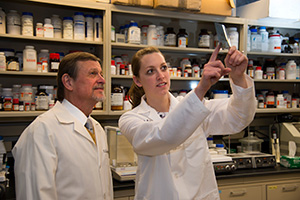Oct. 1, 2014:
A conversation with Timothy L. Ratliff, PhD, Robert Wallace Miller Director of the Purdue University Center for Cancer Research, which is a member of the Big Ten Cancer Research Consortium.
Q: What kind of impact do you see the Big Ten Cancer Research Consortium having on cancer clinical trials?
 The collaborative interactions among Big Ten cancer centers will enable more rapid testing of new therapeutics. In truth, the whole is greater than the parts. By combining forces, multiple institutions will participate in clinical studies, patient accrual will occur more briskly and, therefore, outcomes will be determined more rapidly.
The collaborative interactions among Big Ten cancer centers will enable more rapid testing of new therapeutics. In truth, the whole is greater than the parts. By combining forces, multiple institutions will participate in clinical studies, patient accrual will occur more briskly and, therefore, outcomes will be determined more rapidly.
Q: What are some of the strengths the Purdue University Center for Cancer Research brings to the consortium?
 The Purdue University Center for Cancer Research has significant strength in drug design, biomarker identification, and imaging. Currently, 13 Purdue-developed drugs are in various phases of clinical evaluation (Phase I to Phase II). This is an extraordinary number of new therapeutics from a single center. Further, we have considerable strength in novel label-free imaging technology. These systems allow real-time identification of biomarkers that can assist surgeons in the operating room. Moreover, the technology has identified novel biomarkers that are being validated. The imaging capability also has the potential to determine chemotherapeutic response of tumors early in treatment, well before tumor regression occurs.
The Purdue University Center for Cancer Research has significant strength in drug design, biomarker identification, and imaging. Currently, 13 Purdue-developed drugs are in various phases of clinical evaluation (Phase I to Phase II). This is an extraordinary number of new therapeutics from a single center. Further, we have considerable strength in novel label-free imaging technology. These systems allow real-time identification of biomarkers that can assist surgeons in the operating room. Moreover, the technology has identified novel biomarkers that are being validated. The imaging capability also has the potential to determine chemotherapeutic response of tumors early in treatment, well before tumor regression occurs.
Q: What kind of scientific developments happening at the Purdue University Center for Cancer Research are changing the way we diagnose and treat cancer?
 The Purdue University Center for Cancer Research is one of only seven National Cancer Institute-designated basic science centers in the United States. As a basic science cancer center, we focus on fundamental discovery and work to determine the clinical impact of the discoveries. For example, Dr. Mary Wirth, the W. Brooks Fortune Distinguished Professor of Analytical Chemistry, has developed novel colloidal crystals for nanofluidic bio-separations, a fundamental discovery. This sophisticated, yet simple high throughput technology is being used to evaluate different glycoforms of serum prostate specific antigen (PSA). Some glycoforms of PSA have been linked to aggressive prostate cancer, but validation of such glycoforms as true markers of aggressive prostate cancer has heretofore been impossible. With Dr. Wirth’s technology, it is possible to test samples in a rapid and timely manner, which is allowing studies to validate PSA glycoforms as markers of aggressive prostate cancer.
The Purdue University Center for Cancer Research is one of only seven National Cancer Institute-designated basic science centers in the United States. As a basic science cancer center, we focus on fundamental discovery and work to determine the clinical impact of the discoveries. For example, Dr. Mary Wirth, the W. Brooks Fortune Distinguished Professor of Analytical Chemistry, has developed novel colloidal crystals for nanofluidic bio-separations, a fundamental discovery. This sophisticated, yet simple high throughput technology is being used to evaluate different glycoforms of serum prostate specific antigen (PSA). Some glycoforms of PSA have been linked to aggressive prostate cancer, but validation of such glycoforms as true markers of aggressive prostate cancer has heretofore been impossible. With Dr. Wirth’s technology, it is possible to test samples in a rapid and timely manner, which is allowing studies to validate PSA glycoforms as markers of aggressive prostate cancer.
Q: How will being a part of the Big Ten CRC differ from other collaborative efforts of which your center has been a part?
 The collaboration brings together colleagues with shared visions that will allow focused, rapid evaluation of new therapeutics and new biomarkers.
The collaboration brings together colleagues with shared visions that will allow focused, rapid evaluation of new therapeutics and new biomarkers.
About the Big Ten Cancer Research Consortium: The Big Ten Cancer Research Consortium creates a unique team-research culture to drive science rapidly from ideas to treatment-changing paradigms. Within this innovative environment, today’s research leaders collaborate with and mentor the research leaders of tomorrow with the unified goal of improving the lives of all patients with cancer.
About the Big Ten Conference: The Big Ten Conference is an association of world-class universities whose member institutions share a common mission of research, graduate, professional, and undergraduate teaching and public service. Founded in 1896, the Big Ten has sustained a comprehensive set of shared practices and policies that enforce the priority of academics in student-athletes’ lives and emphasize the values of integrity, fairness, and competitiveness. The broad-based athletic programs of the 14 Big Ten institutions provide nearly $200 million in direct financial aid to almost 9,500 student-athletes for more than 11,000 participation opportunities on 350 teams in 42 different sports. The Big Ten sponsors 28 official conference sports, 14 for men and 14 for women, including the addition of men’s and women’s lacrosse as official sports for the 2014-15 academic year. For more information, visit www.bigten.org.

















Subscribe to the Big Ten CRC Newsletter X
X Facebook
Facebook YouTube
YouTube